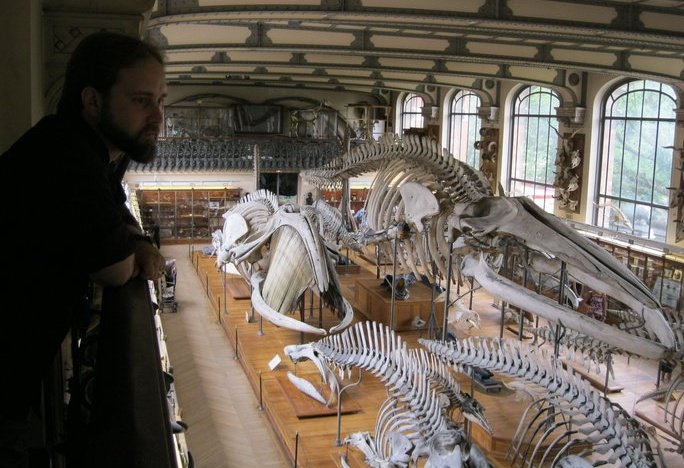Scott Maddux
.
Scott D. Maddux, Ph.D.
Associate Professor
Center for Anatomical Sciences
University of North Texas Health Science Center
Ft. Worth, TX 76107
scott.maddux@unthsc.edu
Ph.D. Anthropology, University of Iowa (2011).
M.A. Anthropology, University of Iowa (2006).
B.A. Anthropology, Texas A&M University (2003).
Curriculum Vitae
Maddux Lab Website
Research
My research focuses on later phases of human evolution with an emphasis on the distinctive craniofacial morphologies of Neandertals and modern humans. My current projects focus extensively on linking evolutionary changes in upper respiratory tract anatomy to physiological demands for respiratory air-conditioning (heat and moisture transfer) in different climates. In particular, my laboratory specializes in the 3D modeling and geometric morphometric analysis of upper respiratory tract anatomy using high-resolution medical imaging modalities (e.g., CT, μCT, MRI). I have also developed a strong collaborative relationship with Dr. Brian Dennis, director of the NSF/DOE/DARPA-funded Computational Fluid Dynamics Laboratory at the University of Texas at Arlington. By merging our two areas of expertise, we have successfully established protocols for quantitatively assessing functional relationships between upper respiratory anatomy and airway physiology under controlled environmental conditions.
Current Projects
-
Climate and ecogeographic variation in human nasal anatomy
-
Evolutionary “mismatches” and modern respiratory health (e.g., asthma, sinusitis, sleep apnea).
-
Developmental integration of nasal/sinus morphology and surrounding facial anatomy
-
Climatic and energetic influences on Neandertal facial morphology and evolution
.
The Maddux Lab is funded by the National Science Foundation (BCS #2020715 & BCS #2050253), the American Association for Anatomy (Innovations Program), and the Texas Center for Health Disparities (via NIMHD Grant 5U54MD006882-09)
 |
.
Selected Publications
- Kelly AP, Ocobock C, Butaric LN, Maddux SD. 2023. Metabolic demands and sexual dimorphism in human nasal morphology: A test of the respiratory-energetics hypothesis. American Journal of Biological Anthropology. 180(3): 415-586.
- Kim S., Ward LA, Butaric LN, Maddux SD. 2022. Human maxillary sinus size, shape, and surface area: Implications for structural and functional hypotheses. American Journal of Biological Anthropology
- Butaric LN, Nicholas C, Kravchuk K, Maddux SD. 2022. Ontogenetic variation in human nasal morphology. Anatomical Record. 305: 1910-1937
- Marks TH, Maddux SD, Butaric LN, Franciscus RG. 2019. Climatic adaptation in human inferior nasal turbinate morphology: Evidence from Arctic and Equatorial populations. American Journal of Physical Anthropology. 169:498-512.
- Maddux SD, Yokley TR, Butaric LN, Franciscus RG. 2017. Ecogeographic variation across morphofunctional units of the human nose. American Journal of Physical Anthropology. 162: 103-119.
- Maddux SD, Butaric LN. 2017. The influence of zygomatico-maxillary morphology on maxillary sinus form and function: How spatial constraints influence pneumatization patterns among modern humans. Anatomical Record. 300: 209-225.
- Maddux SD, Yokley TR, Svoma BM, Franciscus RG. 2016.Absolute humidity and the human nose: A re-analysis of climate zones and their influence on nasal form and function. American Journal of Physical Anthropology. 161(2): 309-320.
- Butaric LN, Maddux SD. 2016. Morphological covariation between the maxillary sinus and midfacial skeleton among sub-Saharan and circumpolar modern humans. American Journal of Physical Anthropology. 160:483-497.
- Maddux SD, Ward CV, Brown FH, Plavcan JM, Manthi FK. 2015. A 750,000 year old hominin molar from the site of Nadung’a, West Turkana, Kenya. Journal of Human Evolution. 80(3): 179-183.
- Wu X, Maddux SD, Pan L, Trinkaus E. 2012. Nasal floor variation among eastern Eurasian Pleistocene Homo. Anthropological Science. 120(3): 217-226.
.
Teaching
At UNTHSC I serve as the course director for Musculoskeletal and Skin System 1 (MEDE 7811) and teach in additional dissection-based anatomy courses to Medical, Physical Therapy, Physician Assistant, and Graduate students.
Courses Taught
- MEDE 7811: Musculoskeletal and Skin Systems 1 (medical students) – Course Director.
- MEDE 7812: Nervous System 1 (medical students).
- MEDE 7615: Cardiopulmonary System 1 (medical students).
- MEDE 7611: Gastrointestinal & Renal Systems 1 (medical students).
- MEDE 7715: Reproductive & Endocrine Systems 1 (medical students).
- DPHT 7200 & 7400: Clinical Anatomy 1 & 2 (physical therapy students).
- MPAS 5401 & 5208: Clinical Anatomy 1 & 2 (physician assistant students).
- SARS 5401: Structural Anatomy (graduate students)



Social media